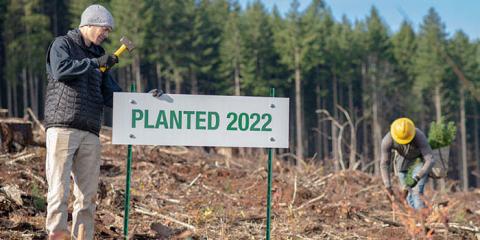How many new trees are planted in Oregon when one is harvested?
March 21, 2022
You may have seen the statistic in some of Oregon Forest Resources Institute’s educational media and other places, that roughly three trees are planted for every one harvested in Oregon. You may have wondered where this figure came from, and if the ratio is universal across all forests. The short answers are 1) it’s an educated estimate of the number of trees forest landowners in Oregon plant for each one they harvest; and 2) It does vary in different forests. Let’s go a little deeper into these questions.
The three-to-one ratio we use in our educational media is a conservative estimate that’s at the lower end of the tree-planting-to-harvesting-ratio spectrum in Oregon. That’s because the ratio depends on both how many trees are planted per acre and how many trees are harvested per acre. Both these numbers can vary based on a number of factors, such as how far apart the trees are planted and the age of the trees when they’re harvested.
First, it’s important to note that our tree-planting-to-harvesting-ratio estimate mostly only applies to western Oregon. The reason for that is western Oregon’s Douglas-fir dominant forests, where the most clearcutting takes place, followed by mass tree planting. Western Oregon forest landowners are also required under Oregon law to replant trees after timber harvest.
The number of trees planted per acre varies with different sites and landowners. Planting is commonly done using 10’ x 10’ spacing, which equals 436 trees per acre (tpa). Some landowners plant a bit tighter and some plant a bit wider, but 436 tpa is a solid average to use.
The number of trees harvested per acre depends on the age of the trees when they’re harvested, the site quality, and past management such as thinning. Some landowners choose to do a commercial thinning, a partial harvest where they cut down some of their trees and sell them to mills to be made into wood products; then they do a full timber harvest years later. The typical age of trees in a full timber harvest is between 50 and 70 years old.
Here are three scenarios that illustrate the spread of ratios:
• A 50-year-old patch (a “stand,” in forester terms) of Douglas-fir trees with no commercial thinning has about 150 tpa at harvest. So 436 divided by 150 equals 2.9, or nearly three trees planted for each one harvested.
• A stand of 70-year-old trees with no commercial thinning has about 110 tpa at harvest. If you divide 436 by 110 that equals 3.96, or nearly four trees planted for each one harvested.
• A stand that was previously commercially thinned and now has 70-year-old trees has about 75 tpa at harvest. In that case, if you divide 436 by 75 you get 5.8, or nearly six trees planted for each one harvested.
You might wonder: How does a newly planted stand go from 436 tpa to only 150 tpa when it’s mature? Is the loss from animals eating tree seedlings, other kinds of tree mortality, or thinning? In those 50 years, how did two-thirds of the original trees planted go M.I.A.?
Great question. The reduction in tree stock is due to self-thinning or competition-induced mortality. As trees get bigger in diameter, they need more room to grow. For trees to reach 16 inches in diameter at breast height (dbh), they need to be about 20 feet apart. The smaller trees die to make room for the bigger trees. A stand of trees 20 feet apart would have about 110 trees per acre.
So there you have it. In Oregon, we plant about three trees for each tree harvested, but in some cases it could be as many as six trees planted for each harvested tree. Aren’t you glad you asked?
For the forest,
Mike Cloughesy
Acting Executive Director
